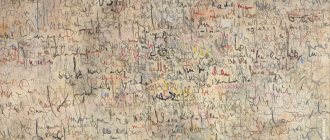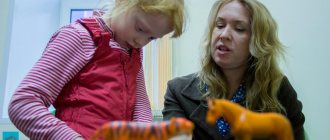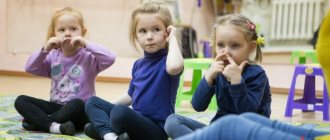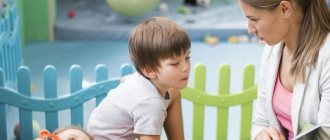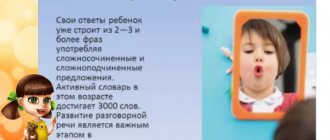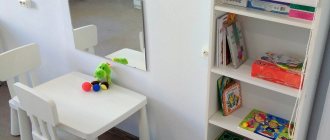Baby's speech
The baby's speech begins to form from the first moments of life. In order for speech development to occur harmoniously and evenly, parents need to become active participants in this process. Attention to the baby’s speech development will bear fruit soon enough when you see a little interlocutor next to you with whom you can have conversations on various topics. The development of a baby’s speech is facilitated by the daily joint work of parents and children.
Successful speech development of young children depends on certain conditions:
- Does the speech apparatus have a normal structure?
- How actively is the baby involved in communication with parents?
- Is the child’s fine motor skills developing?
It's no secret that all children's skills, starting from birth, are practiced in the form of play. The first games for teaching speech should be aimed at improving the speaking process through naming, onomatopoeia, storytelling and exercises for the development of fine motor skills. And for this it is necessary to provide the baby with not only necessary and useful toys and games (rattles, pyramids, cubes, multifunctional toys with inserts, plasticine and paints).
The formation of a child’s speech occurs, first of all, in the presence of active communication with him. It matters how exactly you explain to your baby the names of objects, phenomena and actions; how a child receives information about objects.
"Advice. In order for the baby to better remember the names of objects and actions, you need to verbalize (speak, explain in words) everything that happens around.”
The development of speech in preschool children has been and remains one of the most pressing and important problems of pedagogy and psychology. The importance and significance of this problem lies not only in the fact that it gives an idea of the general patterns of child development, but also introduces the peculiarities of the formation of the personality of a preschooler.
An undoubted contribution to the development of speech development methods was made by K.D. Ushinsky, the idea of nationality that he developed found its response. Including the idea of introducing children to the national culture of the people was and remains relevant. Central to his vast heritage is the teaching of the mother tongue. K.D. Ushinsky outlined the main theoretical principles regarding the role of the native language in the formation of a person in the books “Native Word”, “Children’s World”, “Man as a Subject of Education”.
In his opinion, language is the result of the influence of the objective world on a person and the person’s relationship to it; language reflects the centuries-old experience of the spiritual life of the people (the experience of knowledge, the experience of the moral life of the people, the experience of their aesthetic views), which is transmitted through language to subsequent generations. These and other provisions are the core of his pedagogical concept and determine the methodology he developed for teaching his native language.
A significant contribution was made by E.I. Tikheeva, under whose authorship a domestic system of work on the development of speech in children of early and preschool age was developed. It was E.I. Tikheeva who substantiated the need to develop the speech of preschoolers, formed the goal of the kindergarten’s work in this section, determined the theoretical foundations of the methodology, the main directions of work on speech development, developed the most important sections of the methodology: speech development in the first years of a child’s life, children’s dictionary, classes according to the living word. She poses problematic questions about the need for the development of grammatical structure, the sound culture of a child’s speech, and teaching literacy.
He considers the most important theoretical principles of the method to be the development of speech in communication and activity, and comes to the idea of the need for an adult’s learning influence on the development of a preschooler’s speech and the possibility of creating a program for speech development. The program developed by E.I. Tikheeva was built on the basis of a linguistic approach to speech development: from sound to word, from word to coherent speech. Thus, coherent speech was the last stage in the development of speech in preschool children, and the dictionary was considered as a tool for its development.
In developing these ideas, E.I. Tikheeva returns to the ideas of I.G. Pestalozzi. Therefore, the development of vocabulary in preschool children becomes a central task. An interesting fact is that the theoretical foundations of vocabulary work proposed by E.I. Tikheyeva, a cycle of classes on vocabulary development (excursions, games-activities with toys, inspection of objects, exercises), didactic materials and games (didactic pictures, pictures, etc.), conditions for the development of vocabulary in the process of play and work - all this became a guide to action for subsequent generations of practical workers in preschool education.
It is necessary to note the relevance and significance of those provisions put forward by E.I. Tikheeva on the issue of dictionary work: a visual, sensory basis for the development of the dictionary; active activity position of the child himself; taking into account the interests and capabilities of children; the need to activate children's speech in classes and in everyday communication; creation of a specially organized environment, meaningful communication with children; the need for an adult’s teaching position in the development of children’s speech; the importance of special professional training for teachers to work with preschool children.
E.I. Tikheeva pays great attention to the issues of training personnel for preschool organizations. It defines the requirements for the training of a kindergarten teacher, for example the following: having a higher pedagogical education, knowledge of the psychology of a preschool child, the ability to study it, the ability to bring the work of a kindergarten closer to theory, requirements for the competent and correct speech of the teacher himself.
It was E.I. Tikheeva who came up with the idea of creating a program for the development of speech in preschool children, which was evaluated and implemented only a quarter of a century later; the idea of the possibility of mastering concepts and reflecting them in the speech of preschoolers; the idea of planning work on speech development; the idea of combining learning and everyday communication with the child for targeted language acquisition; the idea of the need for constant support and assessment of the child’s speech achievements in the pedagogical process.
E.I. Tikheeva created her own system of teaching children’s native language in preschool organizations, the leading principles of which are the following:
-activity approach to speech development - speech develops in activity, and above all, in play, through play, in work;
- the relationship between speech development and other aspects of educating a child’s personality (mental, sensory, social, aesthetic, physical education);
-visuality in learning – the child’s language develops visually, and only in the material world will each new word become the property of the child in connection with a clear, concrete idea;
- gradualism and repetition. E.I. Tikheeva advised to gradually increase the number of subjects;; gradually move from listing objects to listing the characteristics and qualities of objects, from individual conversations to collective ones, from the perception of unfamiliar objects to objects that are familiar, but not currently observed, etc.
E.A. Flerina had a significant influence on the development of speech development methods. She viewed teaching her native language in line with the traditions of the national methodology. E.A. Flerina put the content of the speech in the first place. She believed that to enrich the content of speech, sufficient personal experience of the child is necessary; the most productive methods of accumulating experience, according to E.A. Flerina, are observation, play, work, experiment. The clearer, more specific and emotional the accumulation of experience is, the more successfully and with greater interest children rely on it in conversations and conversations.
It should be noted that among the speech tasks E.A. Fleurina emphasized expanding the vocabulary, enriching the structure of speech, working on pure pronunciation, speech culture, its expressiveness, familiarity with fiction, the development of children's verbal creativity, and mastering various forms of living words. She considered the social environment and the organization of the developmental environment in a preschool organization to be important factors in speech development.
E.A. Flerina is credited with creating a system of work to familiarize preschoolers with fiction and introduce them to the art of words. She determined the importance of fiction in the education of preschool children, highlighted the peculiarities of the perception of literary works, identified criteria for selecting works, gave a classification of children's books according to the thematic principle, and developed in detail a methodology for artistic reading and storytelling depending on the age of the children.
An important achievement in the development of the theoretical positions of the methodology was the study of A.M. Leushina under the leadership of S.L. Rubinstein. This collaboration between a psychologist and a teacher, aimed at studying the coherent speech of preschool children under the conditions of pedagogical influence, made it possible to reveal the genesis of coherent speech in general, as well as the true possibilities of a child’s speech development, and to show the pedagogical conditions of this development.
In the works of A.M. Leushina and S.L. Rubinstein for the first time the concept of coherent speech is revealed in connection with the child’s thinking and is associated with the development of mental functions. This gave a new understanding of the semantic core of the methodology and clarified the subject of the methodology for the development of speech as a science. Psychological and pedagogical theoretical and experimental research by A.M. Leushina showed the illegality of identifying such concepts as “language” and “speech”. It was the definition of the unit of speech that made it possible to reconsider the purpose of work on speech development in kindergarten and set priority tasks. Based on the leading communicative function of speech in preschool age, the main goal was the development of speech as a universal means of communication between the child and people around him. To achieve this goal, it is necessary to solve a number of problems, the main one of which is the formation of coherent speech in preschool children. Solving other speech problems (development of vocabulary, grammatical structure, sound culture of speech) is aimed at improving coherent speech as the child grows up.
Developing the conditions for the gradual replacement of a child’s situational speech with contextual one, A.M. Leushina especially emphasizes the role of the adult. An undoubted pressing issue in the works of A.M. Leushina was that she developed a new theory of retelling, which forced her to radically reconsider her attitude towards this type of speech task. This discovery has put forward new requirements for the retelling technique, ranging from the selection of texts, where it is not so much the volume that is important, but the structure, to a specific management technique. These current provisions in relation to issues of speech development in preschoolers have found their distribution and further improvement in the research of A.I. Sorokina, A.F. Uspenskaya, V.R. Bespalova and others.
Thus, it can be noted that in solving methodological issues of children’s speech development, teaching methods are beginning to occupy an increasing place, and activities are beginning to dominate in the forms of work with children.
A student and follower of A.M. Leushina, Vera Iosifovna Loginova, contributes to the development of methods for developing the speech of preschool children. As a result of a detailed analysis of the historical heritage of K.D. Ushinsky and E.I. Tikheeva, relying on the mental research of S.L. Rubinstein, A.V. Zaporozhets, A.A. Leontiev, Vera Iosifovna develops a coherent, logical theory of vocabulary work. This theory made it possible to radically change the accepted ideas about the patterns of speech development in preschool children. The high effectiveness and promise of scientific research, the scientific and practical significance of the results allow V.I. Loginova to rightly be called the author of modern theory and methods of vocabulary work with preschool children. Developing methods for the development of coherent speech in children, V.I. Loginova offers her original author’s classification of language teaching methods. This classification is constructed in accordance with the logic and psychology of mastering a monologue, the age characteristics of preschool children, and takes into account the sequence in which a child masters the skills of monologue coherent speech.
The classes developed by V.I. Loginova on speech development represent an organic unity of pedagogically sound scientific content, impeccable logic and fun children's games. When organizing classes, special attention is paid to motivating the child’s activities. The educational task solved within the framework of the lesson is always presented in the form of an interesting game or creative situation.
Following the principle of conformity to nature, which involves taking into account the age characteristics of children, studying the personality of each child and designing work with him, V.I. Loginova asserts the need to use various forms of work with children - both collective, subgroup and individual.
The candidate dissertations of O.N. Somkova, O.V. Akulova and other researchers were devoted to the study of such important issues as: the influence of system knowledge on the formation and development of artistic and speech creative activity of a preschool child, the role of modern children's literature in the development of a preschool child.
Doctor of Pedagogical Sciences, Professor V.I. Loginova created a large scientific school of specialists in speech development methods. Knowledge of leading domestic and foreign theories and trends in the development of pedagogy, psychology and linguistics allowed her to see the prospects for the development of science and predict its priority areas for research. A whole direction of scientific research has emerged on the impact of learning a foreign language on the development of a child’s speech, on the linguistic aspects of a child’s acquisition of his native language.
It is thanks to the talent of V.I. Loginova as a scientist and teacher, her scientific passion and hard work that in a relatively short period of scientific activity in the field of methods of speech development, her scientific heritage includes a whole range of studied problems: from the history of the formation of methods for the development of speech in preschool children to specific methodological issues and promising directions for its development.
Thus, analyzing the contribution of teacher researchers to the development of methods for the development of speech in preschool children, we note the following: the content of the method has been significantly enriched, thanks to research, the method of speech development has finally emerged from the narrow methodological framework and turned into a science that has stood on a solid theoretical basis; the subject of the methodology for the development of speech as a science was defined, the basic concepts and most important methods were developed, and a theoretical basis was provided for understanding and studying specific issues of the methodology.
Features of speech in early preschool age
Features of speech in early preschool age lie in the different stages of development of the baby’s speech.
Stage 1: screaming. The baby screams when he wants to report a problem, to attract attention to himself. Gradually, screaming becomes a means of communication, the first way to conduct a dialogue. By the third month, the baby learns to change the intonation of cries, by which attentive parents can understand what is causing the dissatisfaction: the child is grumbling, whining, something hurts, he wants to eat, etc.
Stage 2: buzzing. Humming is sound variations: drawn-out pronunciations of “agu”, “agi”, “gee”, “ge”, etc. With this type of speech, interaction is also important. By chanting sounds, the baby seeks contact and tries to build a dialogue. Parents should come into contact with the child, respond in a language he understands, introducing the first words into speech. The child will try to imitate you.
Stage 3: babbling. When the baby is 6-7 months old, he will begin to pronounce the first syllables: “ba”, “pa”, “ma”, etc. Gradually they will be repeated many times, which will precede the appearance of the first words.
“Did you know that humming and babbling are important manifestations of a baby’s speech, which prepare him for further speech development. If you do not see these manifestations, then they need to be stimulated. For example, holding the child close to your face, repeat the syllables clearly, recite poems and sing songs. Talk to your child more often using adult language.”
Stage 4: first words. As the child approaches the age of one year, it is important to help the child say his first words. You need to read aloud more, name all the objects around, comment on all actions. At this stage, speech therapists recommend training the muscles of the cheeks and lips - with the help of whistles, harmonicas and soap bubbles, as well as special articulatory gymnastics (simply put, making faces and depicting emotions).
An important point in the development of the speech of younger preschoolers is the appearance of onomatopoeic, simplified words (“av-av”, “lyalya”, “bibika”, etc.). It is currently difficult for your child to pronounce words correctly, but later, with your help, he will learn to name objects and actions correctly.
Author's methods
I will share my own piggy bank, which contains not just the smartest works, but also the methods and knowledge of people who really love children. Their benefits actively help the process of raising a harmonious personality, nurturing a literate and gifted person:
- The technique developed by Tikheeva , which she expressed in her work “Development of Speech of a Preschooler,” was revolutionary in its time. Now this book helps to understand how important speech is for a baby and his acquisition of vocabulary. And how parents and teachers can help the baby. I will only say about the basic concepts of this technique, what it is about: - Acquaintance with the language goes in parallel with the knowledge of the little one from 3 years old and earlier, the world around him. And this can and should be done unobtrusively, creating a kind of game; - The importance of the process of speech development is that this is part of the mental and psychological state of the baby; - To teach a baby to speak correctly from an early age, you need to have clear speech yourself; - For learning attitude is important. Maintain the toddler’s “joyful interest” in everything that surrounds him.
- Ushakova O.S. in “Theory and practice of speech development in preschool children” spoke about the basics of the development of the speech process, and this is linguistics and psychology. The methodology covers all aspects: grammar, vocabulary and phonetics. Why is the publication interesting? It contains tips about the peculiarities of a child’s speech development at any age, which will be useful for all parents and children of any age, from very young children and even for children 7 years old.
Methods of speech development for preschool children. Oksana Ushakova, Elizaveta Strunina | Buy on OZON.ru | Speech development in children 3-5 years old. | Buy on OZON.ru | Speech development in children aged 5-7 years. | Buy on OZON.ru - Valentina Gerbova presented children and their fathers and mothers, as well as teachers and specialists with a series of publications. In them, the author of the book suggests a program and gives approximate lesson plans for speech development. But what was another pleasant surprise for me personally were recommendations for the selection of literary works aimed at developing the creative abilities of toddlers.
- A book for those who are just starting out according to the Montessori method, you can take tasks from there just like that, for general development. Much attention is paid to the development of reading and writing skills. There are also games for sounds to expand vocabulary. For classes with children from 2.5 to 5-6 years.
Montessori in your home. Speech development. Natalia Bobrova | Buy on OZON.ru
Let me just say that for me it’s desktop publishing. The authors of the books strived for a single goal - to help raise a child who could accurately and competently express his views and feelings. And also, they showed different ways of developing the child’s personality. But the best thing is that all parents of preschool children, as well as teachers of educational institutions, can use the advice.
What benefits help you? Tell us! What is their value? And if you have already been able to try out the tips from them in practice, share the result! Believe me, this will be a valuable contribution to our joint work.
Speech of children 3-4 years old
In 3-4 year olds, speech develops quite quickly. Usually, by the age of three, a child practically masters his native language. The vocabulary of three-year-olds is growing every day: up to 100 new words come into use per month. A four-year-old child already has a vocabulary of about 2 thousand words. In children of this age, the sound design of words becomes better, phrases sound more developed. It should be noted that not all children develop in the same way. Some children have some delay in speech: they speak unclearly, words and individual sounds are pronounced incorrectly. Children often shorten words, skip and rearrange sounds and syllables. The speech of three-year-old children is of the same type and simple. However, even at such an early age, children show interest in words.
What can parents and teachers do?
I was once delighted by Tikheyeva’s idea of raising children based on play. She said the key is to find a compelling story and turn it into a teaching tool. And I took advantage of this. I realized that a personal approach is important here. And what is interesting at 2-3 years old may not affect older people at all. Sometimes, a big book and numerous bright illustrations are all that a baby needs. But for those who are older, the material needs to be informative!
It is worth taking into account the characteristics of toddlers, the foundation of knowledge that is embedded in them, and your goals. You, my good friends, are dealing with the most malleable material. From it you can “blind” whatever you want or whatever you have the strength and courage to do.
For example, raising bilingual children is your conscious choice. You want your child to become fluent in several languages. And you are right, it is much easier to do this at an early age. But then you need to be able to bring the idea to the end, and think about what books to read and what form of education to choose.
But even with knowledge of only one language, development presupposes absolute mutual understanding and interaction between parents and teachers in kindergarten. If they cannot or do not agree to support your work in nurturing your toddler’s personality, you should not trust them with your Miracle!
Environment for speech development
For successful speech development of a child, it is necessary to create conditions that would contribute to the formation of good speech skills. Such conditions can be created both in a preschool institution and in the family. The developmental environment will provide different types of activity for the younger preschooler (speech, mental, physical and play) and will successfully form his independent speech activity.
So, what needs to be done to create a cozy environment at home, rich in a variety of educational gaming and educational materials?
- At home, conditions must be created for the baby’s independent activity - for play, cognition, movement, imagery.
- Items in the child’s room should be suitable for the baby’s age and correspond to his interests and needs.
- At home, communication between the child and adults should be organized.
- Parents should help organize the child’s contacts with peers.
- Mom and dad should offer the child books, pictures, toys, and objects for independent study in order to deepen knowledge about the world around them.
- You can organize a “corner” of interesting things with didactic materials that encourage speech activity.
- Parents should not only actively communicate with the child, naming all actions, but also read and study in the direction of speech development.
Thus, a well-prepared developmental environment will contribute to the formation of speech skills of younger preschoolers and will ensure their independent natural speech development.
Methods of speech development in the Age of Enlightenment
During this period, special attention was paid to speech development. Theories of speech development were outlined in the works of great scientists: I.G. Pestalozzi, K.D. Ushinsky, M.V. Lomonosov.
I.G. Pestalozzi continued the development of Comenius's views on the speech development of preschool children. They identified three stages in the formation of a preschooler’s speech:
- Studying the sounds and sound composition of words.
- Word study.
- Speech learning.
He developed a system of exercises focused on cognitive and speech development, based on the principle of clarity.
M.V. Lomonosov argued that the development of speech is required for the general development of a child, as well as for his cultural social formation. In his opinion, the beauty of language underlies the development of the younger generation and society.
Figure 1. From the history of speech development methods. Author24 - online exchange of student work
K.D. Ushinsky created his own language learning system. She assumed language learning in primary school, but her ideas could also be used in preschool pedagogy.
The basis of language teaching, according to Ushinsky, is the principle of nationality. Language is connected with the people and their history. His knowledge helps in understanding the connection with the people, penetration into their spirit. Therefore, training and education should be implemented in the native language.
Ushinsky developed a sound analytical-synthetic method of teaching literacy.
We walk and talk
You can develop the speech of younger preschoolers on walks. Such “activities” are very natural, bring children a lot of impressions, and contribute to their knowledge of the world. While walking, the baby will begin to ask a lot of questions, many of which encourage the thought process and require the expression of emotions and thoughts using words. And all parents can do is communicate with the child, expanding his vocabulary, enriching his knowledge. This is how the child learns new words and concepts that will soon become mandatory in his everyday speech. Don't be afraid that the baby won't understand you. During these valuable moments of communication, the baby listens and learns to perceive his native speech.
“Did you know that walking is one of the most effective ways to develop a child’s speech? All that remains is to organize it correctly.”
During the walk we recommend:
- describe everything that surrounds you
- keep your baby interested in what is happening around him
- use different parts of speech to name objects, their signs and actions
- speak emotionally and intonation richly, in a calm tone.
Educational didactic games
At the age when the child gradually moves from babbling to words (1.5-2 years), you can start playing useful didactic games with him for speech development:
- “What object is this?” The mother takes the prepared toy out of the bag, describes it, and then offers to describe it to the baby.
- “Guess what toy.” There are 3-4 toys in front of the baby. Mom describes one of them, and the baby guesses it from the description.
- “Describe the doll.” The mother invites the child to describe the doll in detail.
- "Mystery Box" Mom put themed pictures in a bright box in advance. The kid takes out one picture at a time and describes what he sees.
- “Tell me what object?” The child takes toys out of the box and names their characteristics (adjectives).
- "Wonderful cubes." The baby throws a dice with pictures. The red picture appears - the child says what he sees and gives a description of the depicted object.
- “Where is the toy?” The mother lays out toys in the room and invites the child to name where each of them is located. Mom should tell the baby how to correctly use the words “in”, “on”, “behind”, “under”, “about”, “next to”, “between”, “right”, “left”.
- "Postcard". The mother shows the child postcards with images of people and animals performing different actions. The child must name what action is depicted on the postcard.
These games are suitable for children from 1.5 to 4 years old. There are many such games. Parents, if desired, can come up with them themselves, making activities with their baby enjoyable leisure time, full of the joy of new discoveries.
